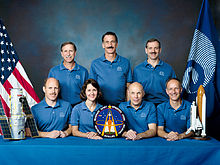
Back STS-61 Arabic STS-61 Bulgarian STS-61 Czech STS-61 Danish STS-61 German SM1 Spanish STS-61 Estonian استیاس-۶۱ Persian STS-61 French STS-61 Galician
 Musgrave being raised to the top of Hubble by Canadarm, as it sits in Endeavour's payload bay. | |
| Names | Space Transportation System-61 |
|---|---|
| Mission type | First Hubble Space Telescope servicing |
| Operator | NASA |
| COSPAR ID | 1993-075A |
| SATCAT no. | 22917 |
| Mission duration | 10 days, 19 hours, 58 minutes, 33 seconds (achieved) |
| Distance travelled | 7,135,464 km (4,433,772 mi) |
| Orbits completed | 163 |
| Spacecraft properties | |
| Spacecraft | Space Shuttle Endeavour |
| Launch mass | 113,541 kg (250,315 lb) |
| Landing mass | 94,972 kg (209,377 lb) |
| Payload mass | 8,011 kg (17,661 lb) |
| Crew | |
| Crew size | 7 |
| Members | |
| Start of mission | |
| Launch date | December 2, 1993, 09:27:00 UTC |
| Rocket | Space Shuttle Endeavour |
| Launch site | Kennedy Space Center, LC-39B |
| Contractor | Rockwell International |
| End of mission | |
| Landing date | December 13, 1993, 05:25:33 UTC |
| Landing site | Kennedy Space Center, SLF Runway 33 |
| Orbital parameters | |
| Reference system | Geocentric orbit |
| Regime | Low Earth orbit |
| Perigee altitude | 291 km (181 mi) |
| Apogee altitude | 576 km (358 mi) |
| Inclination | 28.45° |
| Period | 93.30 minutes |
| Capture of Hubble Space Telescope | |
| RMS capture | December 4, 1993, 08:48 UTC |
| Berthing date | December 4, 1993, 09:26 UTC |
| RMS release | December 9, 1993, 10:26 UTC |
 STS-61 mission patch  Standing: Covey, Hoffman, Akers Seated: Bowersox, Thornton, Musgrave, Nicollier | |
STS-61 was NASA's first Hubble Space Telescope servicing mission, and the fifth flight of the Space Shuttle Endeavour. The mission launched on December 2, 1993, from Kennedy Space Center (KSC) in Florida. The mission restored the spaceborne observatory's vision (marred by spherical aberration in its mirror) with the installation of a new main camera and a corrective optics package (COSTAR). This correction occurred more than three and a half years after the Hubble was launched aboard STS-31 in April 1990. The flight also brought instrument upgrades and new solar arrays to the telescope. With its very heavy workload, the STS-61 mission was one of the most complex in the Shuttle's history.
STS-61 lasted almost 11 days, and crew members made five spacewalks (extravehicular activities (EVAs)), an all-time record; even the re-positioning of Intelsat VI on STS-49 in May 1992 required only four. The flight plan allowed for two additional EVAs, which could have raised the total number to seven; the final two contingency EVAs were not made. In order to complete the mission without too much fatigue, the five EVAs were shared between two pairs of different astronauts alternating their shifts. During the flight, mission specialist Jeffrey A. Hoffman also spun a dreidel for the holiday of Hanukkah to a live audience watching via satellite.